Index

Review: 18% GPU overclock, 14% performance gain
Today we will be talking about another Nvidia GTX 750 Ti card, the company's first Maxwell based product that features a low price and relatively low consumption, yet it promises fairly good performance. The GTX 750 Ti was released a month ago and the card we'll be taking a look at today comes from Gainward. The full name of the card is Gainward GTX 750 Ti Golden Sample 2048MB GDDR5 128B CRT DVI mHDMI.
The GTX 750 Ti uses the GM107 GPU, which is based on the all new Maxwell architecture. New GPU features 640 shaders, 16 ROPs, 40 TMUs and five streaming multiprocessors (SMs).
A very similar product based on the same GPU is the GTX 750 without the Ti suffix. This card has four streaming multiprocessors, 512 shaders, 16 ROPs and 32 TMUs.
The GTX 750 Ti has 2GB of memory, which is enough for gaming at 1080p or lower resolutions. The plain GTX 750 features 1GB of memory, but Gainward and many other AIB partners also have GTX 750 cards with 2GB of memory.
Nvidia's Maxwell architecture delivers exceptional performance per watt, made possible by redesigning and optimizing the existing Kepler architecture. The GTX 750 and GTX 750 Ti use about half as much power as old GTS 450 and GTX 550 Ti cards, hence they can even deliver smooth 1080p gaming without external power. The GTX 750 Ti delivers a twofold improvement in performance over the GTX 550 Ti.
The GTX 750 Ti is said to have a 60W TDP and the GTX 750 has a 55W TDP. The card does not even use the full potential delivered by the PCIe slot (75W).
Gainward's Golden Sample is just one of many cards with a non-reference cooler and there are other factory overclocked models from other vendors as well, however the Golden Sample is among highest clocked GTX 750 Ti cards out there. The reference card comes with a base clock of 1020MHz (1085MHz Boost), while the Golden Sample card comes with a Base clock of 1202MHz (1281MHz Boost). The reference memory bandwidth is 86.4 GB/s, and the Golden Sample’s bandwidth is 96.1 GB/s because the Gainward card comes with factory overclocked memory that runs at 6008MHz GDDR5 (reference 5400MHz).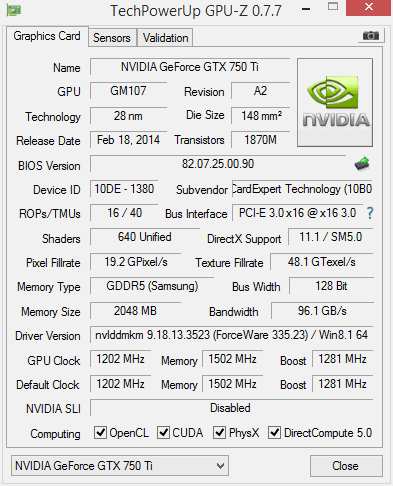
The box is pretty nice. It is not too big, it's just the right size. You will only get the card, manual, driver and utility disc. The card has mini HDMI, Dual-link DVI-D and VGA outputs so you will probably need separate purchase for the standard HDMI converter.


The cooler looks like it should have no trouble keeping the temperatures and noise emissions in check. We’re talking about a dual-slot cooler with two 7cm fans on top. Gainward took an open shroud approach, where fans are positioned on top and blow directly at the heatsink, but this approach means that hot air will not be vented out of the chassis. Adequate airflow is necessary to ensure the best possible cooling, but it’s nothing that a few quality intake and outtake fans won’t effectively nullify. What's more, this is not a 150W or 200W card - it won't generate much heat, so this is hardly something to moan about.
The next picture shows the GTX 750 Ti Golden Sample in all its glory. The card itself is 245mm (10 inch) long due to its non-reference cooler, but the PCB measures only 150mm in length. The reference GTX 750 Ti with cooler is also 150mm long.
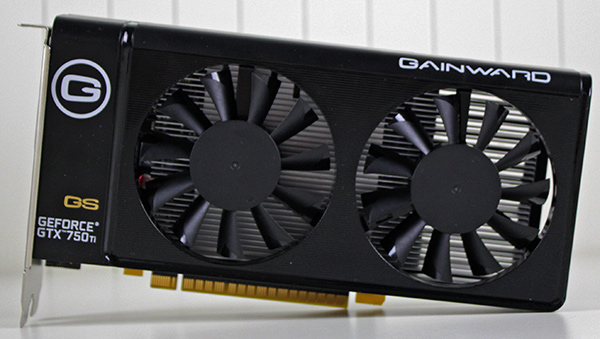
The Golden Sample card does not require any additional power connector. All the juice the card needs is supplied via the PCIe connector.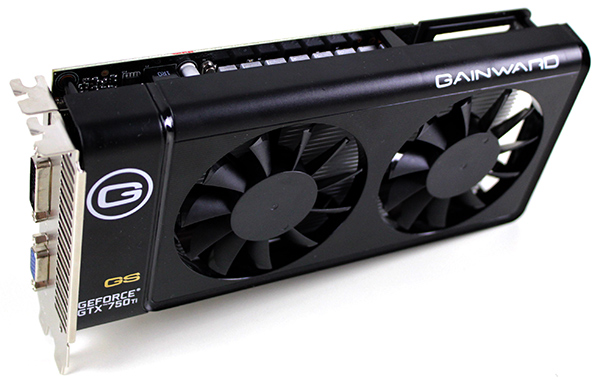
Since it's not a high-end product, Nvidia dropped SLI support on the GTX 750 Ti (with the GTX 650 Ti SLI was not possible, but it was supported on the GTX 650 Ti Boost). As you can see from the picture the card does not come with an SLI connector.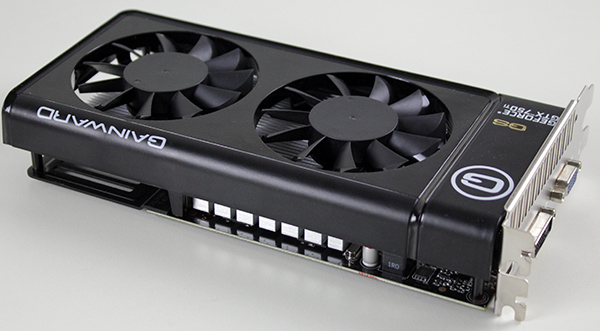
The DVI port on the card supports both DVI-I and DVI-D. Additionally you will get a mini HDMI port, but the converter is not included. You can use all three outputs at the same time. The reference card comes also with one mini-HDMI connector, but it has two DVI ports, one of which supports analog VGA output.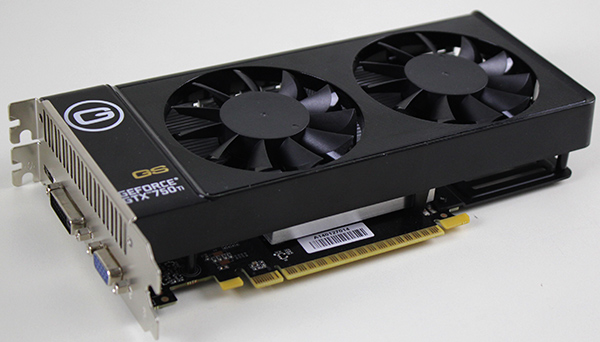


Just to illustrate the difference, this is what a reference GTX 750 Ti looks like. The low TDP, courtesy of the new Maxwell GPU, allows Nvidia to use a simple all-aluminum heatsink that reminds us of old Intel stock coolers.
We were somewhat disappointed when we took the shroud off and looked under the bonnet. Gainward's cooler is oversized and it has a big heatsink, but there are no heatpipes, no copper base, nothing fancy to help the cooler distribute heat from the core to the fins. However, thanks to our earlier reviews we already know that the GM 107 GPU does not produce much heat anyway. This fact allowed Gainward to go for a hefty factory overclock, raising the GPU base clock by 182MHz (18% overclock). Two fans will hopefully should help keep it cool and the fact that the cooler does not really require heatpipes is a testament to Maxwell's efficiency.
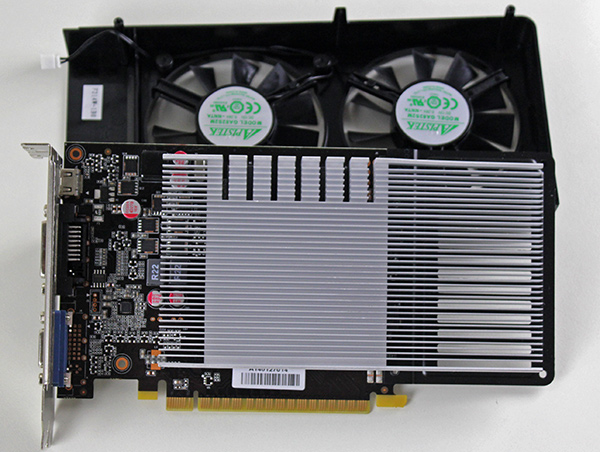
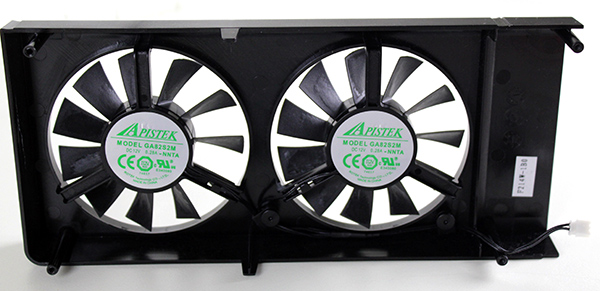
The card has 2GB of GDDR5 memory, courtesy of Samsung. The chip designation is K4G41325FC-HC03. All memory modules are on the GPU side of the PCB. The heatsink only deals with heat dissipation from the GPU, while memory and power components are cooled indirectly by airflow.
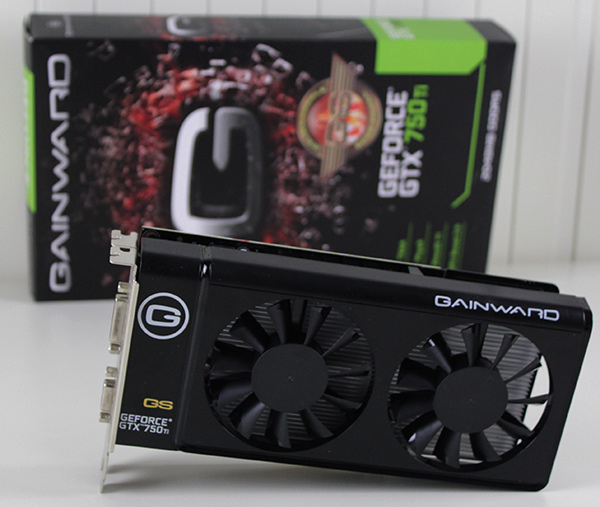
Testbed:
- Motherboard: Intel DZ87KLT-75K
- CPU: Intel Core i7 4770K, 4x3.5GHz (Haswell)
- CPU Cooler: EVGA
- Memory: 2x4GB Corsair DDR3 2400MHz
- Harddisk: Corsair Neutron GTX 240GB
- Case: CoolerMaster Cosmos II
- Operating System: Win8.1 64-bit
- Motherboard: EVGA Z-87 Stinger
- CPU: Intel Core i7 4770K, 4x3.5GHz (Haswell)
- Memory: 2x4GB Corsair DDR3 2400MHz
- Harddisk: Corsair Neutron GTX 240GB
- Case: EVGA Hadron Air
- CPU Cooler: EVGA
- Operating System: Win8.1 64-bit
Drivers:
- Nvidia GeForce 335.23 WHQL drivers
- AMD Catalyst 14.2 V1.3 Beta for Windows
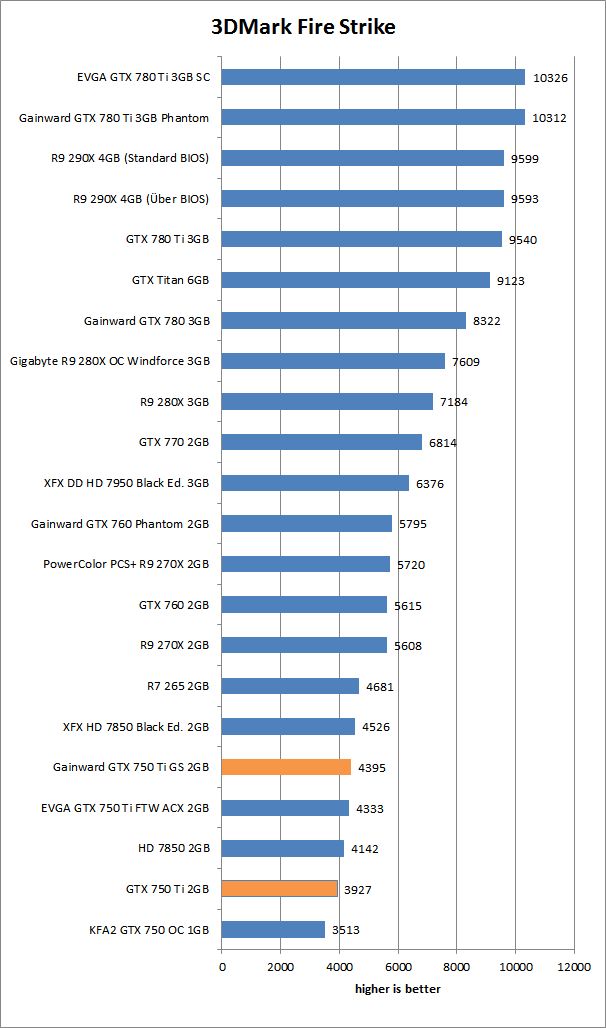
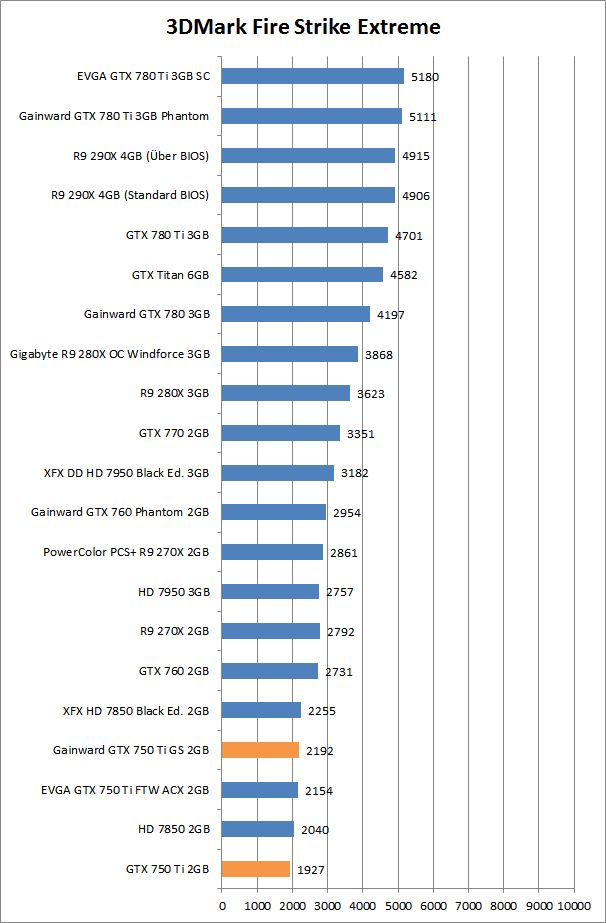
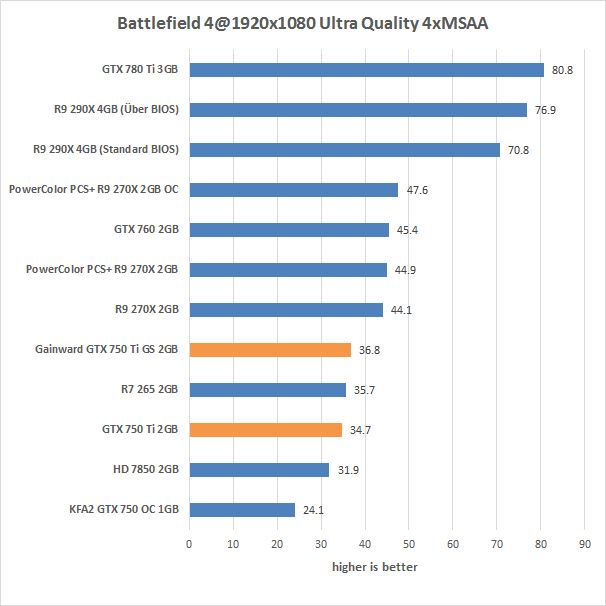
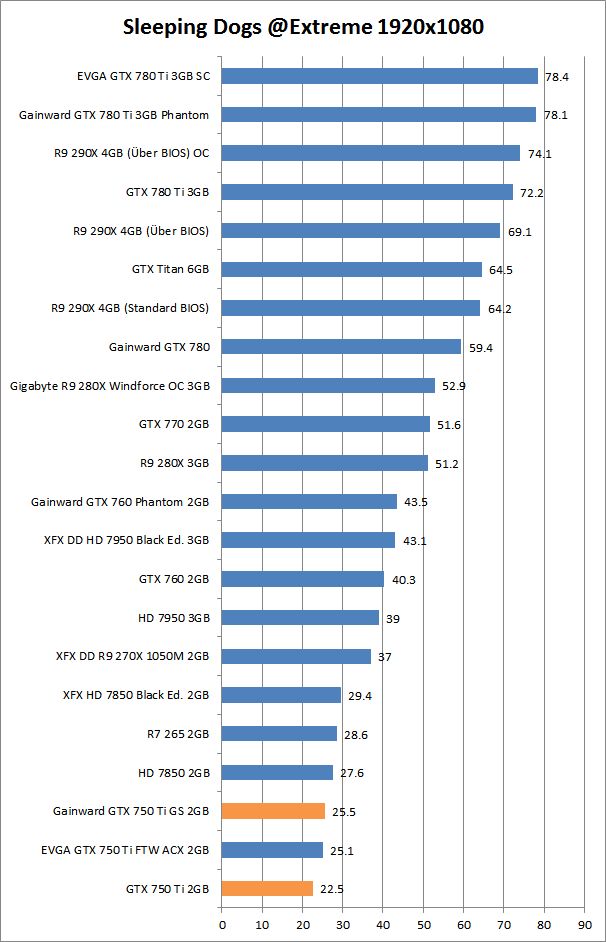
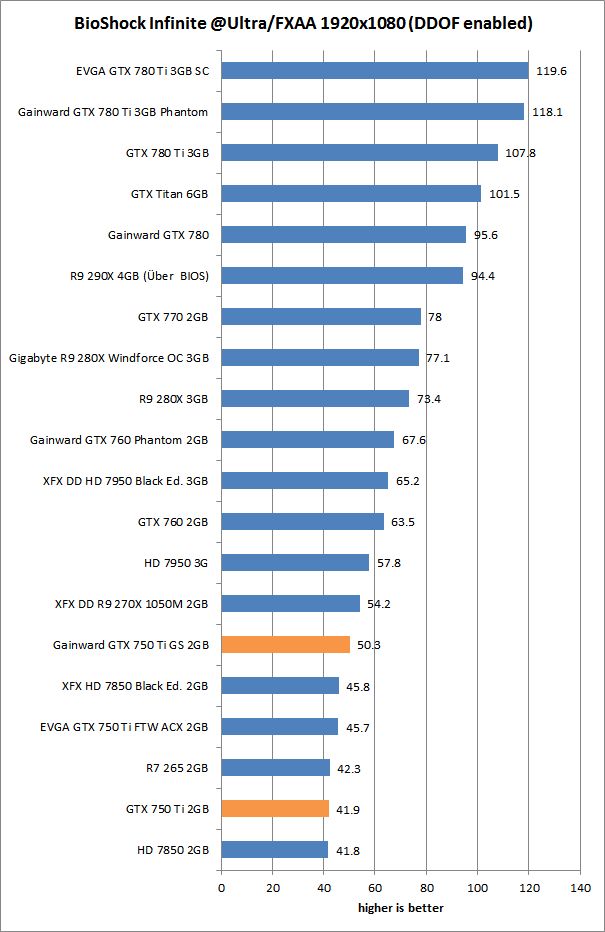
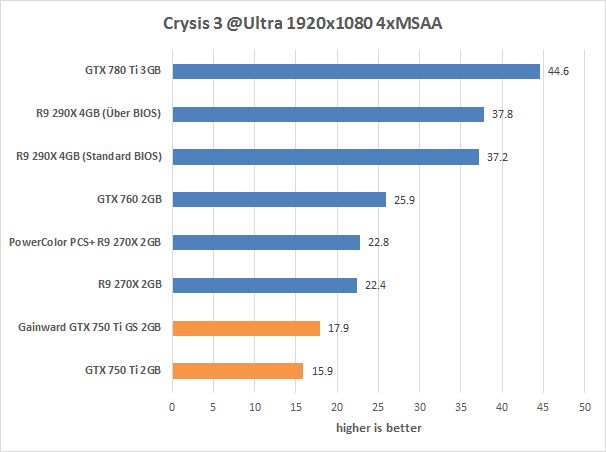
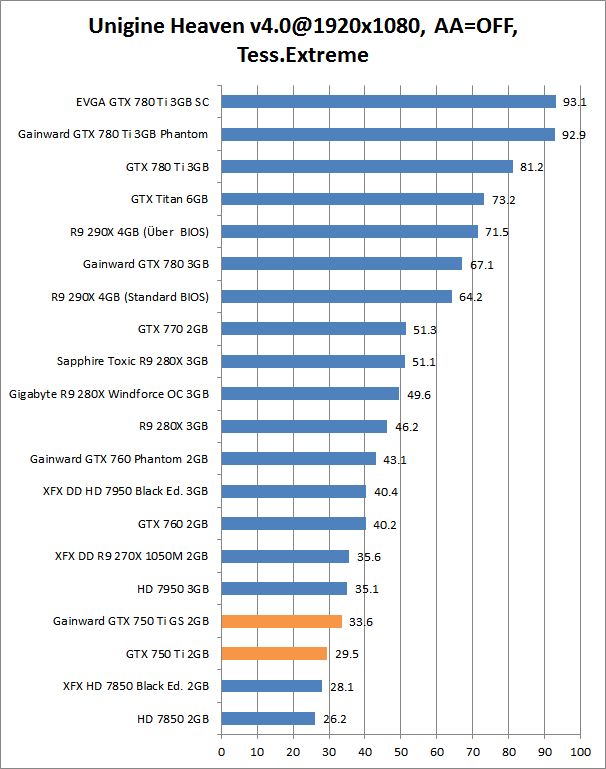
While idling the GPU temperature ranged from 32 to 34 degrees Celsius. The fans are silent in idle mode.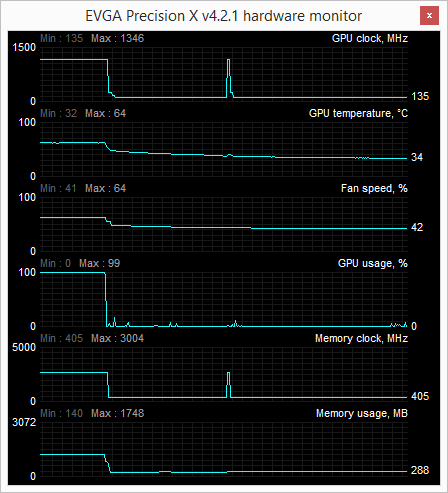
Although the cooler is relatively simple, with no copper base or heatpipes, it has a relatively big surface. With two fans on top, it is more than adequate given the relatively low TDP of the GM107. Let's not forget that the card is factory overclocked by 182MHz, either.
During our standard game benchmarks, we noticed that the card tends to change the speed fan when monitoring tools like PrecisionX or MSI Afterburner are used. When the tools aren't running, the fans are silent and don't run faster than 41% RPM, even when running games. The temperature tends to increase slightly higher than on other GTX 750 Ti cards we had a chance to test. The maximum temperature recorded during our tests was 74 degrees Celsius. This is still a safe temperature and we like the fact that Gainward optimized the card for silence rather than sheer cooling performance. Keep in mind the 41% RPM does not really correspond to noise level when compared to other cards, because the actual RPM and noise will vary from card to card.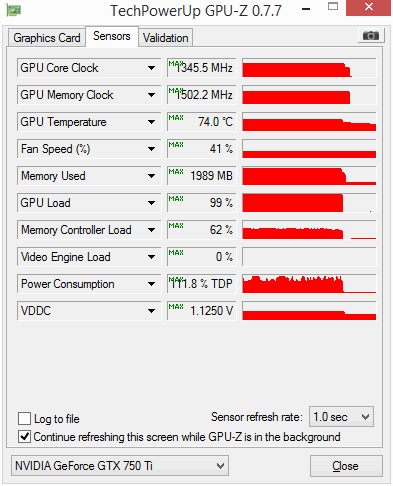
In essence, users who are looking for silence should consider this card, as it balances silence and performance rather well. If for some reason you believe the temperatures are too high, you can activate the PrecisionX tool and allow the fans to speed up automatically to 64% RPM under load. This is enough to reduce the temperature by about ten degrees, but at the same time the fans become audible. Even at 64% the fans are relatively quiet, they're not loud enough to annoy you, not even close.

You can also use Gainward ExperTool to check or set some values.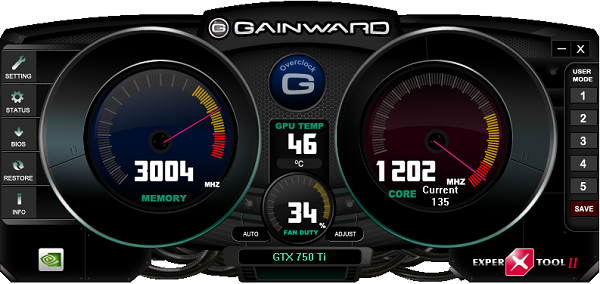
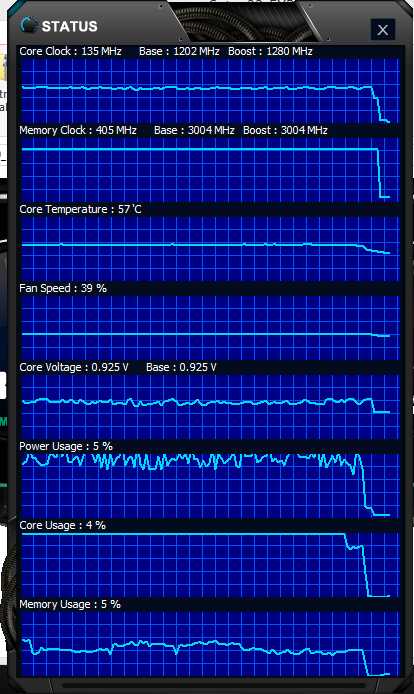
In terms of power efficiency, we can report that the Gainward GTX 750 Ti GS can draw a bit more juice (some 10W more) than the reference GTX 750 Ti. This is the result of its high factory overclock that provides 15% better performance, but as you can see from the graph below the whole system draws less than 200W. This means the Golden Sample does rather well. AMD's R7 265 is a little bit faster in games, but GTX 750 Ti GS is much better in terms of power consumption. In idle we measured just over 100W for the whole system. Needless to say these are very impressive figures for a system capable of running most games at 1080p, with plenty of detail to boot.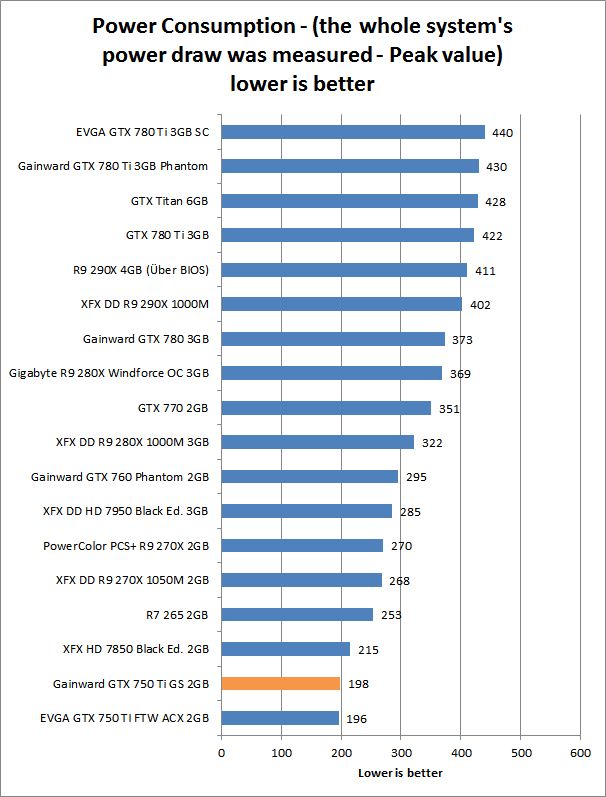
The GTX 750 Ti Golden Sample card comes with a high factory overclock which sets the GPU base clock at 1202MHz, while the reference GPU base clock is set at 1020MHz. Nvidia's GPU Boost 2.0 takes the average GPU clock to 1085MHz for the reference GPU and to 1281MHz for the GS card. The GPU clock offset slider can still be adjusted, so we tried it and using the standard voltage and AUTO fan settings we managed to push the GPU 60MHz over the factory clocks. The overclocking potential is very good considering that this is a factory overclocked card.
Memory overclocking is vital in any attempt to squeeze out more performance from a graphics card. Our memory overclocking run resulted with a total 130MHz (effective 520MHz) overclock. Overclocking resulted with about additional 6% bump in performance.
All in all, there is still some headroom for overclocking, which is impressive given the 18% factory overclock.
The GTX 750 Ti is an attractive card for games on budget. The reference Geforce GTX 750 Ti sells from €120, while the Radeon HD R7 265 sells for about €130.
The Golden Sample (GS) card comes with a factory overclock and a custom quiet cooler and these extras will add a €15 premium. We are talking about a huge 182MHz overclock (18% overclock) and this makes difference as we saw about 14% better results compared to the reference GTX 750 Ti. The R7 265 offers on average 13% more performance compared to the reference GTX 750 Ti, but the Golden Sample card managed to compete with the R7 265 rather well. On average, the Golden Sample card consumes 40W less that the R7 265. It is question of user preference, do you care about consumption or not? We care and so does AMD. For years AMD marketed its Radeons as having superior performance-per-watt, but this is no longer the case, thanks to Maxwell. Despite high factory overclock, Golden Sample offers additional overclocking potential.
Of course, price plays a huge role in the mid-range market segment and in this case it is rather tempting. In fact, we dare say that Gainward’s new Golden Sample is one of the best graphics cards you can get for less than €140 today. It does not need a fancy, overpriced cooler to overclock well, and it does not need external power connectors. However it doesn't provide SLI feature. All these savings add up, making the card relatively cheap to produce. Efficiency also allows end-users to save cash when choosing a PSU, since frugal cards and processors don't need a fancy and pricey PSU to deliver plenty of performance.

